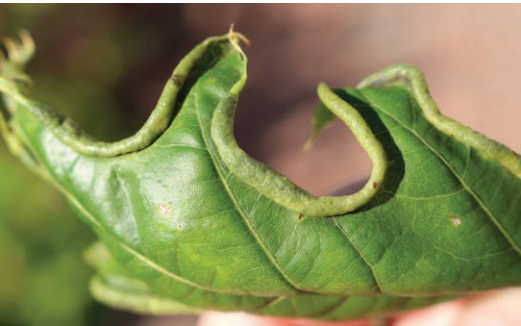Oak Itch Mites

A few people in Butler County are itching due to this tiny mite. This mite, not an insect, bites humans, causing itchy bites and, in some cases, secondary bacterial infections. Oak mites prefer pin oaks but will also live on red or black oaks. These mites are associated with another insect, the oak marginal leaf fold gall, and that is one way you can tell if your oak tree is infested since they are so tiny they are microscopic.
The oak marginal leaf fold gall midge lays eggs on the margins or edges of leaves, leading to the edges rolling, similar to the photo above. The female oak mites enter the leaf fold gall and inject a neurotoxin in the larvae of the midge that formed the gall so she can feed upon that larvae. The females then lay 200 to 300 eggs in the gall. Once the eggs hatch, they become adults in a week; the males mate with the females and then die. Oak leaf itch mites emerge from the leaf galls in late July and continue to feed through fall till they drop from the trees to overwinter in leaf litter on the ground. It’s estimated that as many as 400,000 mites can fall from a tree in a day, either carried by the wind or falling to the ground. These mites land on humans or pets to eventually bite them.
Bites usually occur on the upper body around the neck, shoulders, and chest where the mites land, but they may also show up on hands or arms if you pet an animal with the mites on them. These bites can be distinguished from chigger bites from their location, as they don’t occur in areas where clothes are tight. After landing on a human, oak leaf itch mites start biting, and symptoms appear in 10 to 16 hours. Bites may be visible on the skin as raised, red areas with a small, centralized blister. The itchy bites can be painful when scratched, and scratching can lead to secondary bacterial infections.
Unfortunately, very few strategies prevent oak leaf itch mites from infesting your oak trees. Repellants used for chiggers or mosquitos are not effective against these mites, and miticide sprays will not reach these mites due to the gall they are hiding in. One prevention strategy is to use Tanglefoot as a two-inch band about five feet above the ground to prevent the mites from reaching the galls in the tree. The best way to prevent getting bitten is to avoid oak trees with leaf fold galls on them and take a bath when you get home to wash the mites off. If you get bitten, use anti-itch creams to minimize the itch.

Have questions? Contact our office where our Horticulture Extension Agent will assist you with questions.
Phone: (316) 321-9660
Email: callae@ksu.edu